Published 19 Jul 2025
Which Type of Hearing Aid is Best? | IIC vs CIC vs RIC
Compare IIC, CIC, and RIC hearing aids in this expert guide. Discover the best hearing aid for your hearing loss, age, lifestyle, and budget. Explore top models, key features, and expert tips.
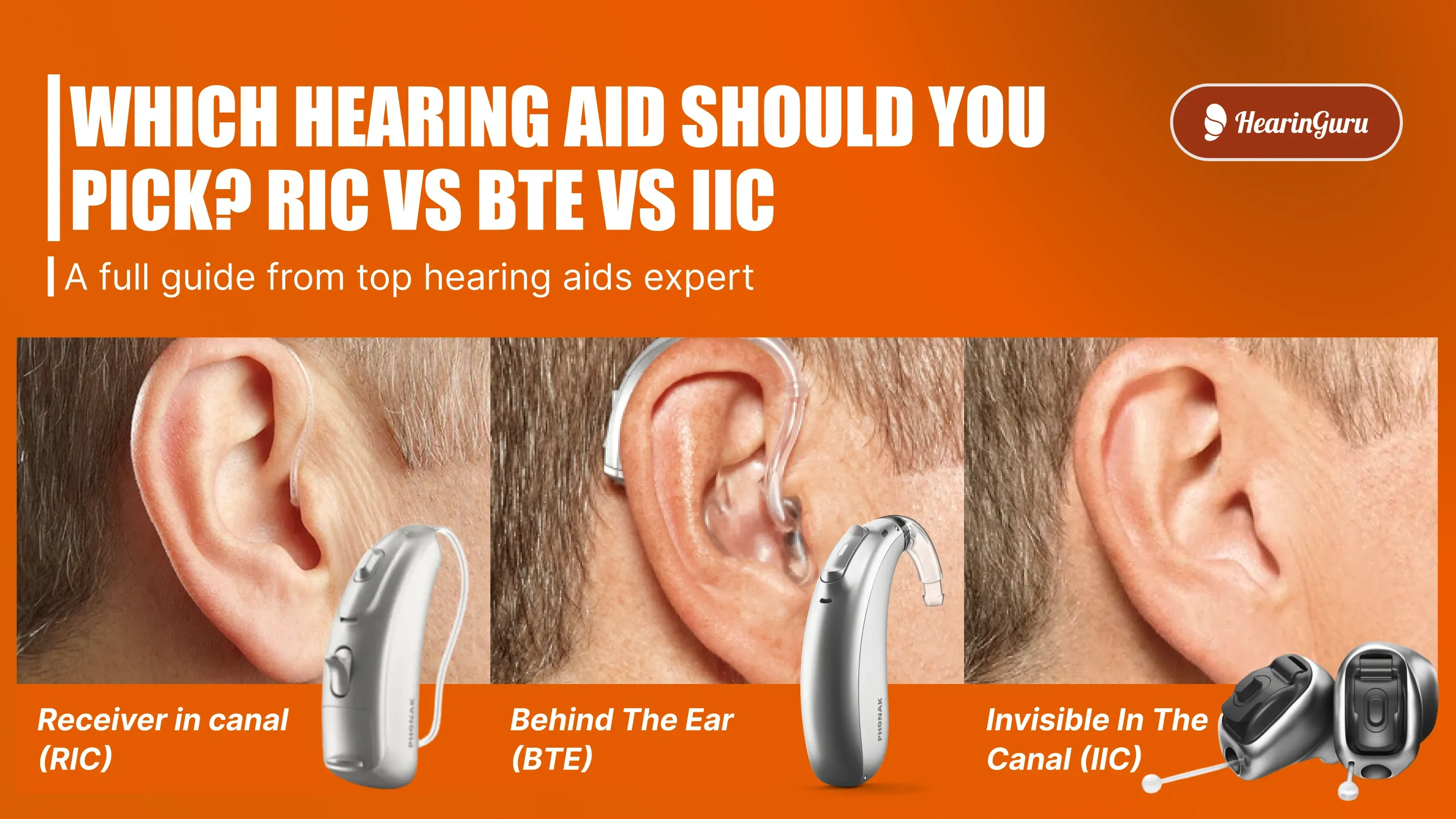
Introduction
1.1 What is a Hearing Aid?
A hearing aid is a small electronic device designed to improve hearing by amplifying sound for individuals with hearing loss. It typically consists of a microphone, amplifier, speaker, and power source. These devices are custom-programmed based on the user’s audiogram (hearing test results) and are essential tools for people experiencing mild to profound hearing impairment.
Hearing aids help users hear more clearly in various environments—whether it’s during conversations, in noisy restaurants, or while watching TV. Unlike cochlear implants, which are surgically implanted, hearing aids are external and non-invasive.
Modern hearing aids often come equipped with digital signal processing, Bluetooth connectivity, noise reduction features, feedback suppression, and in many cases, AI-based sound adjustment.
1.2 Why Are There Different Types of Hearing Aids?
There are several types of hearing aids, primarily differing in their design, placement in or on the ear, and functional capabilities.
The reason for this variation is to accommodate a wide range of:
Hearing loss levels (mild, moderate, severe, profound),
Ear anatomy and personal comfort,
Aesthetic preferences (invisible vs. visible),
Lifestyle and activity levels,
Technological needs, and
Budget considerations.
The three most popular styles are:
RIC (Receiver-in-Canal): Known for flexibility, comfort, and performance.
CIC (Completely-in-Canal): Discreet and partially visible.
IIC (Invisible-in-Canal): Virtually hidden deep in the ear canal.
Each type has specific pros and cons, which is why audiologists recommend different models based on individual hearing profiles and daily needs. As hearing technology evolves, these hearing aid types continue to improve in sound quality, wireless features, and battery efficiency.
2. Understanding the Types of Hearing Aids
Hearing aids come in various styles and configurations as we had seen in the above sections, mostly these are to meet individual hearing needs, aesthetic preferences, and lifestyle demands. SPOILER ALERT : the most widely used types are Receiver-in-Canal (RIC), Completely-in-Canal (CIC), and Invisible-in-Canal (IIC) hearing aids. And thus we will be dealing with them in the coming sections. Each of these offers unique advantages and trade-offs in terms of sound quality, visibility, comfort, and technology integration. Let's buckle up to unveil the factors that make them the best and life-changing for your hearing needs.
2.1 RIC (Receiver-in-Canal) Hearing Aids
Receiver-in-Canal (RIC) hearing aids are among the most popular and versatile models available today. In this design, the microphone and processor sit behind the ear, while the receiver (or speaker) is placed directly into the ear canal via a thin wire. This separation allows for clearer sound delivery and reduced feedback.
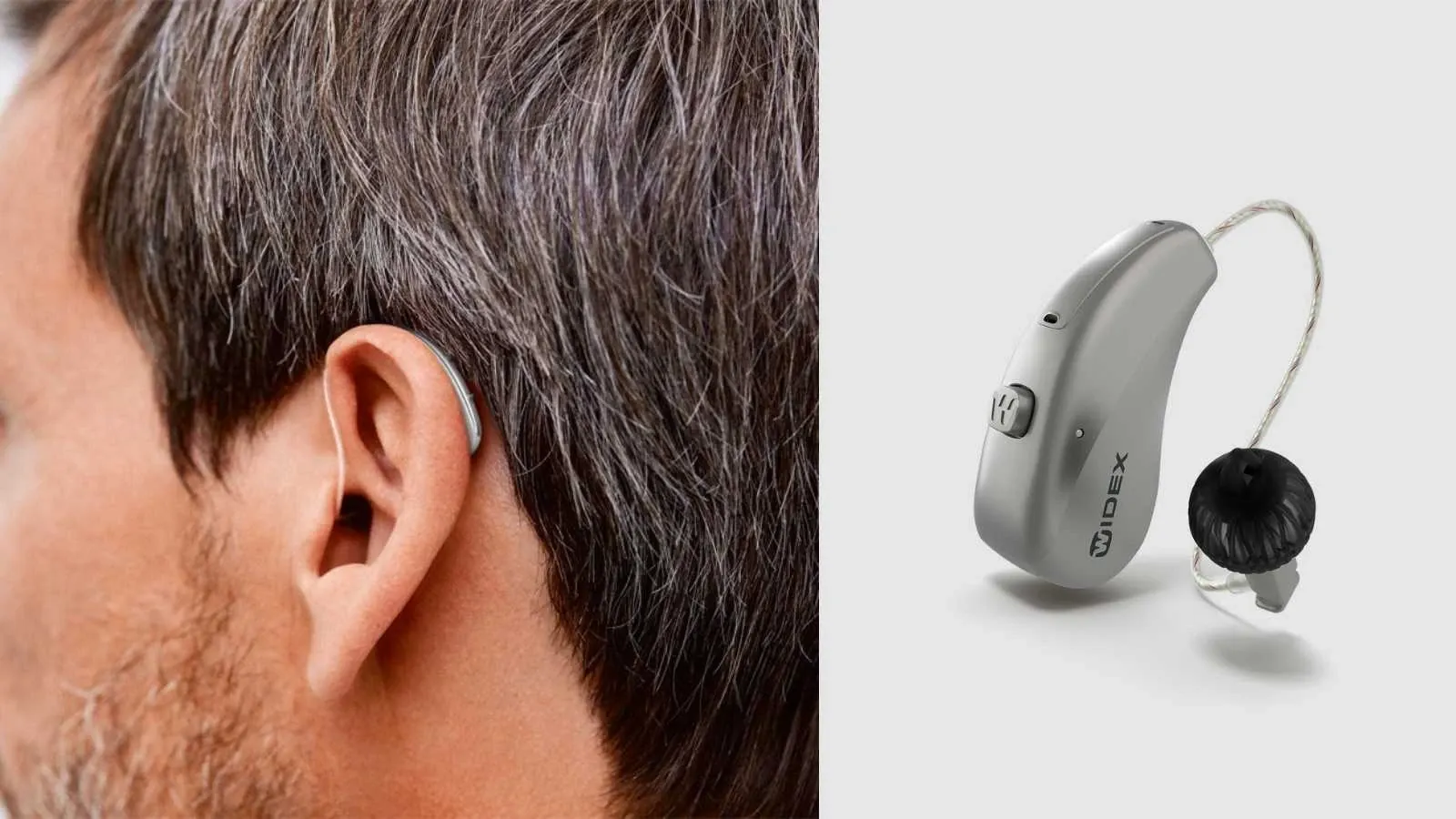
Key Features of RIC Hearing Aids: Suitable for mild to severe hearing loss Often includes advanced features like Bluetooth connectivity, rechargeable batteries, and noise filtering More comfortable due to open-fit design Discreet and lightweight behind-the-ear appearance Pros: Excellent sound quality and natural sound perception Compatible with wireless accessories and mobile apps Easily adjustable and serviceable Cons: Slightly visible behind the ear Receiver can be more susceptible to moisture or earwax RIC hearing aids are ideal for users seeking a balance between performance, aesthetics, and cutting-edge technology.
2.2 CIC (Completely-in-Canal) Hearing Aids
Completely-in-Canal (CIC) hearing aids are custom-molded devices that fit entirely within the ear canal. They are more discreet than RIC models and are popular among users who prioritize subtlety.
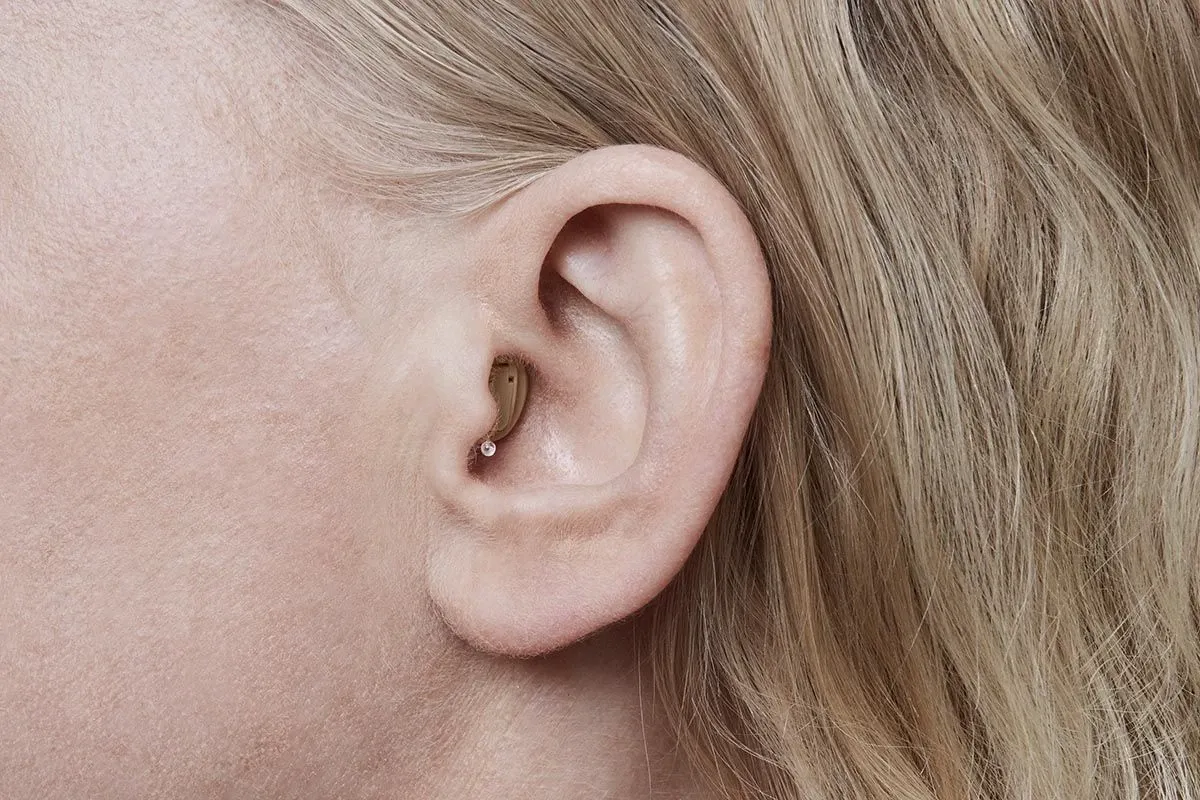
Key Features of CIC Hearing Aids:
Suitable for mild to moderately severe hearing loss
Custom-fit for comfort and sound delivery
Less visible than RIC models
Pros:
- Low-profile, nearly invisible in the ear
- Natural sound quality due to placement
- Minimal wind noise interference
Cons:
- Smaller size means fewer tech features (e.g., no Bluetooth in some models)
- Shorter battery life due to smaller batteries
- Can be difficult to insert or remove for users with dexterity issues
CIC hearing aids offer a discreet solution for users who want hearing improvement without visible devices, though with some limitations in advanced functionality.
2.3 IIC (Invisible-in-Canal) Hearing Aids
Invisible-in-Canal (IIC) hearing aids are the smallest and most discreet option on the market. These are placed deeper in the ear canal than CIC devices and are virtually invisible when worn.

Key Features of IIC Hearing Aids:
Best for mild to moderate hearing loss
Custom-designed for individual ear canals
Almost completely hidden from view
Pros:
Ultra-discreet—perfect for those concerned about appearance
Natural hearing experience with direct sound entry
Low wind noise and occlusion
Cons:
Very limited space for features like Bluetooth or rechargeable batteries
May not be suitable for severe hearing loss
Requires regular maintenance due to wax/moisture exposure
IIC hearing aids are ideal for individuals who prioritize invisibility and aesthetics, especially in professional or social settings.
3. Best Model on Each Type
With advancements in audiology and sound technology, the hearing aid market offers a variety of high-performance models across different types. Here’s a curated list of the top models in each category—RIC, CIC, and IIC—known for their sound quality, reliability, and user-friendly features.
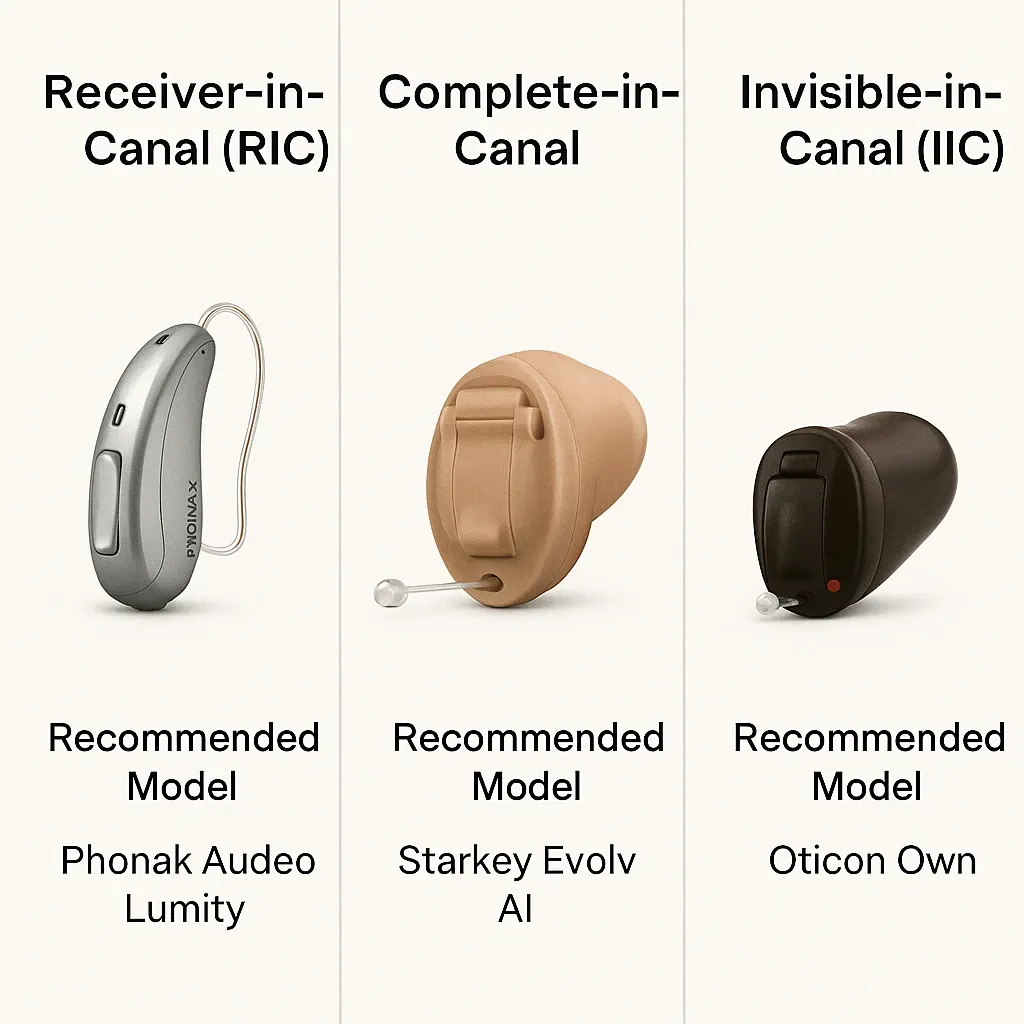
3.1 Best RIC (Receiver-in-Canal) Hearing Aid Models
1. Phonak Audeo Lumity
Key Features: Bluetooth streaming, rechargeable, waterproof (select models), AI-driven AutoSense OS™ Ideal For: Active users who want premium sound clarity and connectivity Tech Highlights: Advanced directional microphones, myPhonak app, speech enhancer
2. ReSound ONE
Key Features: M&RIE receiver (microphone & receiver in ear), Natural sound, Bluetooth LE Audio Ideal For: Individuals seeking natural hearing with a personalized soundscape Tech Highlights: Ultra Focus, binaural beamforming, all-day power
3. Oticon More
Key Features: Deep neural network (DNN) processing, rechargeable, iPhone/Android compatible Ideal For: Users prioritizing speech understanding and brain-friendly hearing Tech Highlights: BrainHearing™ technology, wide dynamic range compression
3.2 Best CIC (Completely-in-Canal) Hearing Aid Models
1. Starkey Evolv AI CIC
Key Features: Discreet size, Bluetooth in select models, advanced feedback suppression Ideal For: Users who want a balance of discretion and modern tech Tech Highlights: AI sound processing, wellness tracking (in select models)
2. Signia Silk X
Key Features: Instant fit with silicone sleeves, remote control via app Ideal For: First-time users or those looking for convenience Tech Highlights: Binaural OneMic directionality, flexible fitting
3. Unitron Insera
Key Features: Custom-fit design, automatic environment classification Ideal For: Those who prioritize simplicity and high-quality audio Tech Highlights: SoundCore platform, anti-feedback system.
3.3 Best IIC (Invisible-in-Canal) Hearing Aid Models
1. Phonak Lyric (Extended Wear)
Key Features:
- 100% invisible
- worn 24/7 for months
- no battery changes
Ideal For: Users seeking complete invisibility and low maintenance
Tech Highlights: Deep canal placement, natural sound without daily handling
2. Starkey SoundLens Synergy iQ IIC
Key Features:
- wireless option available,
- high customization
Ideal For: Those desiring discreet devices with advanced sound quality
Tech Highlights: Acuity Immersion technology, feedback control
3. Signia Insio Charge&Go AX IIC (Note: some models are nearly invisible)
Key Features:
- Rechargeable (in select styles)
- Own Voice Processing
Ideal For: Users looking for near-invisibility with premium features
Tech Highlights: Augmented Focus™ for speech clarity, motion sensors
4. Recommendations Based on Hearing Loss, Age, and Technology
Selecting the right hearing aid is not solely about the type or style—it’s about matching a device to the user's hearing profile, age group, technological expectations, and budget. Below is a comprehensive guide to help determine which hearing aid (RIC, CIC, or IIC) is best suited for various conditions and user preferences.
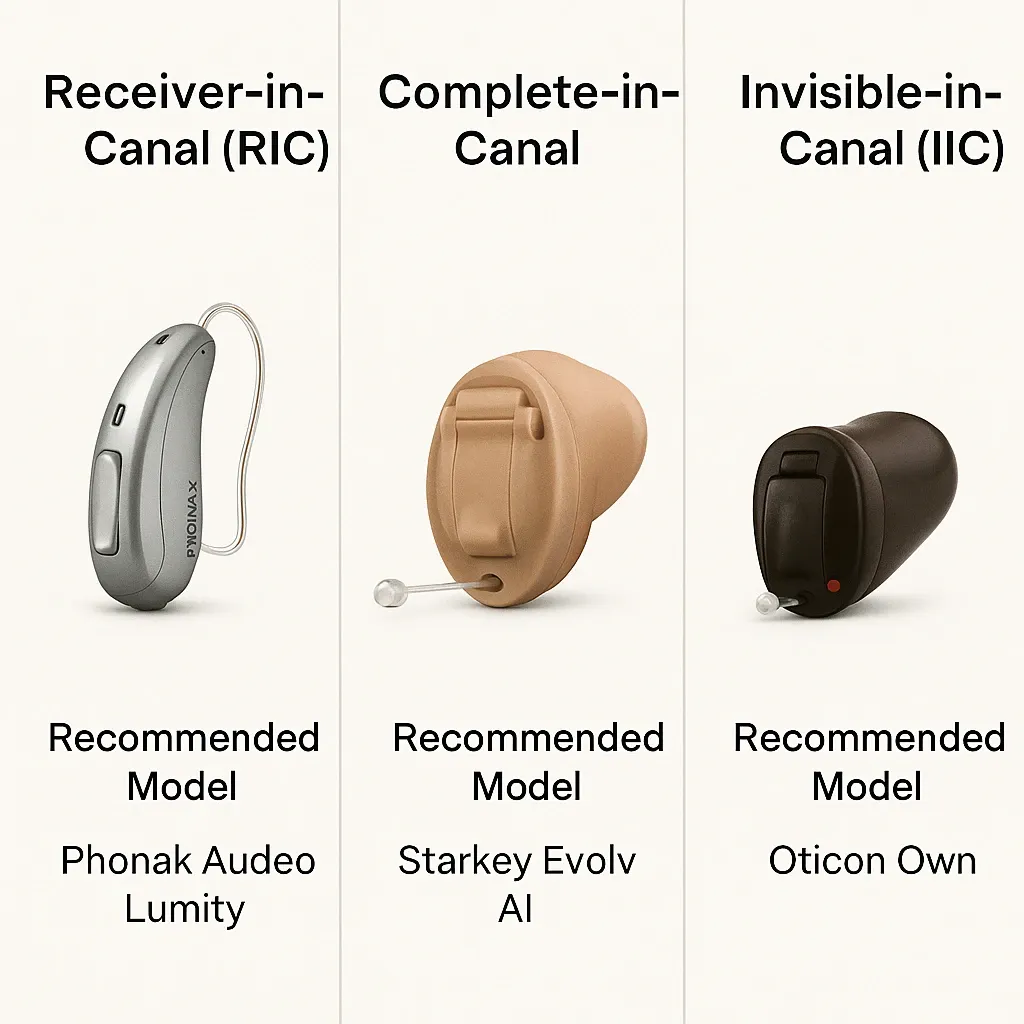
4.1 Bluetooth-Enabled Hearing Aids
Modern hearing aids increasingly feature Bluetooth connectivity, enabling seamless pairing with smartphones, TVs, and other devices. Best for Tech-Savvy Users or Professionals Recommended Models: Phonak Audeo Lumity (RIC), Starkey Evolv AI CIC Type Preference: RIC offers more robust Bluetooth features due to space for antennas and chips Use Cases: Hands-free calls, media streaming, remote adjustments Note: Bluetooth is rarely available in IIC due to size constraints.
4.2 Rechargeable vs. Battery-Powered Hearing Aids
Rechargeable hearing aids offer convenience and sustainability, while battery-powered options provide longer usage time in smaller devices. Rechargeable Hearing Aids Ideal for: Seniors, users with dexterity issues Type: Mostly found in RIC, limited in CIC Pros: Easy overnight charging, cost-effective over time Models: ReSound ONE, Oticon More Battery-Powered Hearing Aids Ideal for: Users needing ultra-compact designs Type: Predominantly CIC and IIC Pros: Smaller size, longer wear without charging Cons: Requires regular battery replacement.
4.4 Based on Hearing Loss Type
Degree of Hearing Loss Recommended Type Why Mild to Moderate IIC, CIC, or RIC All types suitable; discretion or tech based on user choice Moderate to Severe RIC Powerful amplification, advanced features Severe to Profound High-power RIC Best for strong amplification and wireless features IIC is not recommended for severe or profound hearing loss due to limited amplification capabilities.
4.5 Technology vs. Price Considerations
Budget-Friendly Options CIC or IIC (basic models), battery-operated May lack Bluetooth or rechargeability Brands: Unitron, Signia Silk Mid-Range Entry-level RICs with rechargeability Good balance between price and performance Brands: Widex, ReSound Premium RIC models with AI, Bluetooth, remote programming Brands: Phonak Lumity, Oticon Real, Starkey Genesis AI
5. Full Comparison: RIC vs CIC vs IIC Hearing Aids
Choosing the right type of hearing aid often involves comparing multiple aspects beyond just appearance or fit. Below is a comprehensive comparison of Receiver-in-Canal (RIC), Completely-in-Canal (CIC), and Invisible-in-Canal (IIC) hearing aids based on key decision-making factors.
5.1 Comparison Based on Technology Features
Feature | RIC | CIC | IIC |
|---|---|---|---|
Bluetooth connectivity | ✅ Widely available | ⚠️ Limited availability | ❌ Rare due to size limitations |
Rechargeable Battery | ✅ Common | ⚠️ Select models only | ❌ Not typically supported |
Noise Cancellation | ✅ Advanced algorithms | ✅ Moderate | ⚠️ Limited due to small size |
Smartphone App Control | ✅ Fully supported | ✅ Partially supported | ❌ Rarely supported |
Remote Fitting / Support | ✅ Yes | ⚠️ Sometimes | ❌ Rarely available |
Verdict: RIC hearing aids lead in terms of technological capability, offering the most comprehensive feature set, ideal for tech-savvy or highly active users.
5.2 Comparison by Style and Physical Fit
Aspect | RIC | CIC | IIC |
|---|---|---|---|
Visibility | ⚠️ Slightly visible | ✅ Low-profile | ✅ Completely invisible |
Comfort | ✅ Comfortable, open fit | ✅ Custom molded | ⚠️ Deep fit may cause discomfort |
Fit & Removal | ✅ Easy to handle | ⚠️ Requires dexterity | ⚠️ Can be difficult to remove |
Customzation | ✅ Yes (tip/dome options) | ✅ Custom shell | ✅ Fully custom |
Verdict: If aesthetics and discretion are priorities, IIC is the most invisible, while RIC offers better handling and comfort for most users.
5.3 Comparison by Price Range
Price Category | RIC | CIC | IIC |
|---|---|---|---|
Entry-Level | ₹25,000 – ₹40,000 | ₹20,000 – ₹35,000 | ₹25,000 – ₹40,000 |
Mid-Range | ₹40,000 – ₹75,000 | ₹35,000 – ₹65,000 | ₹40,000 – ₹70,000 |
Premium | ₹75,000 – ₹2,50,000+ | ₹65,000 – ₹1,50,000 | ₹70,000 – ₹2,00,000 |
Verdict: CICs can be more budget-friendly but may lack advanced features. RICs offer the best value for feature-to-price ratio.
5.4 Comparison Based on Hearing Loss Severity & User Type
By Loss Level
User Type | Best Type | Reason |
|---|---|---|
Mild Hearing Loss | IIC,CIC | Discreet, suitable for mild amplification |
Moderate Hearing Loss | RIC, CIC | Balanced power and features |
Severe to Profound Loss | RIC | Strong amplification, advanced processing |
By Lifestyle
User Type | Best Type | Reason |
|---|---|---|
Children/Teenagers | RIC | Discreet, suitable for mild amplification |
Older Adults | RIC or CIC | Balanced power and features |
Tech Enthusiasts | RIC | Strong amplification, advanced processing |
Budget-Conscious Users | CIC or basic RIC | Cost-effective, decent performance |
Verdict: RIC hearing aids offer the broadest compatibility across hearing levels and demographics, while IIC excels in cosmetic invisibility.
5.3 Price Range Comparison: RIC vs CIC vs IIC Hearing Aids
Price plays a major role in choosing the right hearing aid. The cost varies depending on technology level, brand reputation, customization, and additional services like remote support or aftercare. Below is a detailed breakdown of RIC, CIC, and IIC hearing aids by entry-level, mid-range, and premium segments.
💰 Entry-Level Hearing Aids (₹20,000 – ₹40,000)
Type Typical Price Range What You Get Recommended For
Hearing Aid type | Price Range | Recommended for |
|---|---|---|
RIC | ₹25,000 – ₹40,000 | Basic digital processing, limited manual programs, standard batteries First-time users, mild to moderate loss |
CIC | ₹20,000 – ₹35,000 | Compact design, essential amplification, minimal tech Cosmetic-focused users on a budget |
IIC | ₹25,000 – ₹40,000 | Smallest size, very basic amplification, no wireless features Users who want invisible design affordably |
Note: Entry-level models usually lack features like Bluetooth, rechargeability, and AI-based sound processing.
💼 Mid-Range Hearing Aids (₹40,000 – ₹75,000)
Type Typical Price Range What You Get Recommended For
Hearing Aid type | Price Range | Recommended for |
|---|---|---|
RIC | ₹45,000 – ₹70,000 | Directional microphones, basic Bluetooth, rechargeable battery in some models Professionals, active users |
CIC | ₹40,000 – ₹65,000 | Improved noise control, better sound processing, slightly longer battery life Users looking for both design & quality |
IIC | ₹45,000 – ₹70,000 | More natural sound, some models may offer wireless tuning Appearance-conscious users with mild/moderate hearing loss |
Note: Mid-range hearing aids often offer a good balance of discretion, functionality, and user customization.
👑 Premium Hearing Aids (₹75,000 – ₹2,50,000+)
Hearing Aid type | Price Range | Recommended for |
|---|---|---|
RIC | ₹75,000 – ₹2,50,000+ | AI-based sound processing, full Bluetooth streaming, rechargeability, app control, remote fitting Tech lovers, severe hearing loss, comfort seekers |
CIC | ₹65,000 – ₹1,50,000 | Advanced clarity, feedback suppression, partial app control, custom programs Audiophile users wanting aesthetics and performance |
IIC | ₹70,000 – ₹2,00,000 | Invisible fit, improved clarity, limited wireless tech, high customization Users prioritizing full discretion with higher budgets |
Note : Premium models deliver the best in comfort, performance, and personalization, with features like smartphone streaming, AI sound adjustments, and tele-audiology support.
💡 Key Takeaways:
- RIC hearing aids provide the best value at each price point and offer the widest feature set.
- CIC hearing aids balance aesthetics and performance, ideal for those who prefer discreet yet functional options.
- IIC hearing aids, while more expensive per feature, are best for users prioritizing invisibility over tech.
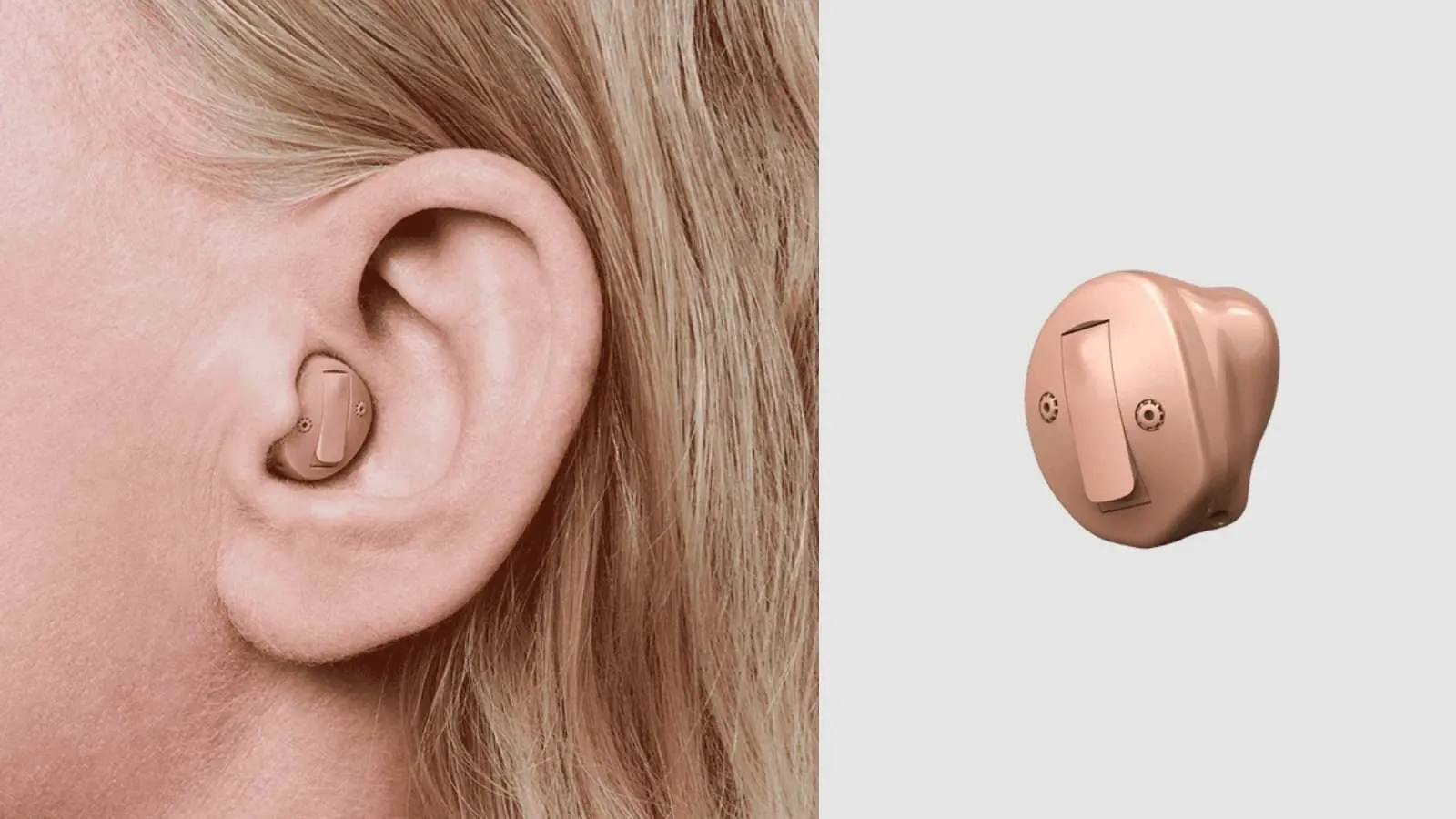
6. Conclusion: Which Hearing Aid Type Is Best for You?
Choosing the best type of hearing aid—whether RIC, CIC, or IIC—ultimately depends on an individual's hearing needs, lifestyle, budget, and preference for visibility or technology.
RIC (Receiver-in-Canal) hearing aids are the most versatile and technologically advanced, making them ideal for users with mild to severe hearing loss. They offer the most features, such as Bluetooth streaming, rechargeable options, AI-enhanced sound, and remote support. They are a great all-around choice for most age groups, especially for those who value performance over invisibility.
CIC (Completely-in-Canal) hearing aids strike a balance between discreet design and functional technology. Best suited for mild to moderately severe hearing loss, CICs are often preferred by individuals who want something less visible but still effective. They come with custom-fit comfort and are available at a wide range of price points, making them a good mid-tier option.
IIC (Invisible-in-Canal) hearing aids are designed for those who prioritize maximum invisibility and cosmetic appeal. Best for mild to moderate hearing loss, these devices are nearly invisible when worn but may lack certain advanced features due to their ultra-compact size. IICs are perfect for users who want their hearing aids to remain unnoticed.
✅ Final Thoughts When selecting a hearing aid, consider these core factors:
- Severity of hearing loss (mild, moderate, severe)
- Your daily lifestyle and tech usage
- Budget range and long-term value
- Comfort, fit, and ease of use
- Aesthetic preferences
Always consult a qualified audiologist to get your hearing professionally evaluated. A personalized fitting and trial experience will ensure you choose the device that meets your expectations both clinically and personally.
No single type is “best” for everyone—the best hearing aid is the one that best supports your hearing journey and quality of life.

Dr Sudheer Pandey